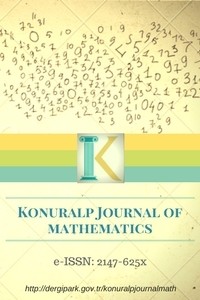Some Properties of Leonardo Numbers
In this paper, we consider the Leonardo numbers which is defined by Catarino and Borges. Using Binet's formula of this sequence, we obtain new identities of the Leonardo numbers. Also , we give relations among the Fibonacci, Lucas and Leonardo numbers. Finally, using the matrix representation of Leonardo numbers, we obtain some identities of Leonardo numbers.
Keywords:
Fibonacci number Lucas number, leonardo number,
___
- [1] P. Catarino and A. Borges, On Leonardo Numbers, Acta Mathematica Universitatis Comenianae, Vol:89, No.1 (2019), 75–86.
- [2] P. Catarino and A. Borges, A Note on Incomplete Leonardo Numbers, Integers, Vol:20 (2020).
- [3] C. Kızılates, On the Quadra Lucas-Jacobsthal Numbers, Karaelmas Science and Engineering Journal, Vol:7, No.2 (2017), 619-621.
- [4] E. G. Kocer, N. Tuglu and A. Stakhov, On the m extension of the Fibonacci and Lucas p numbers, Chaos, Solitons&Fractals, Vol:40, No.4 (2009), 1890–1906.
- [5] Koshy, T., Fibonacci and Lucas numbers with Applications, John Wiley&Sons, 2001.
- [6] A. G. Shannon, A Note On Generalized Leonardo Numbers, Notes on Number Theory and Discrete Mathematics, Vol:25, No. 3 (2019), 97-101.
- [7] N. J. A. Sloane, The On-line Encyclopedia of Integers Sequences, The OEIS Foundation Inc., http.//oeis.org.
- [8] R. R. Stone, General identities for Fibonacci and Lucas numbers with polynomial subscripts in several variables, Fibonacci Quarterly, Vol:13 (1975), 289-294.
- [9] N. Tuglu, C. Kızılates and S. Kesim, On the harmonic and hyperharmonic Fibonacci numbers, Advances Difference Equations, Article number: 297 (2015).
- [10] Vajda, S., Fibonacci and Lucas numbers and the Golden Section: Theory and Applications, Halsted Press,1989.
- [11] R. P. M. Vieira, F. R. V. Alves and P. M. Catarino, Relacoes Bidimensiona is E Identidades Da Sequencia De Leonardo, Revista Sergipana de Matematica e Educacao Matematica, No. 2 (2019), 156-173.
- Yayın Aralığı: Yılda 2 Sayı
- Başlangıç: 2013
- Yayıncı: Mehmet Zeki SARIKAYA
